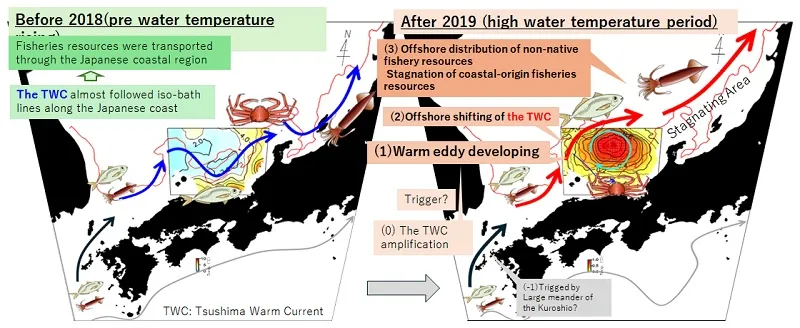A03-K109 Elucidation of processes that drastic changes in the distribution of fishery resources can be caused by the Tsushima Warm Current meandering
A03-K109
Principal Investigator
| IGETA Yosuke | Fisheries Resources Institute |
Research Collaborators
| SAKUMA Kay | Fisheries Resources Institute |
| MIYAHARA Hisae | Fisheries Resources Institute |
| TAKAHASHI Motomitsu | Fisheries Resources Institute |
| MUKO Soyoka | Fisheries Resources Institute |
| WAGAWA Taku | Fisheries Resources Institute |
| NAGAI Taira | Fisheries Resources Institute |
| ABE Shoko | Fisheries Resources Institute |
| KIDA Shinichiro | Kyushu U., Co-I of A01-1 |
| HIROSE Naoki | Kyushu U. |
| TANAKA Yuki | Tokyo University of Marine Science and Technology |
| ITO Daiki | Fisheries Resources Institute |
| ISHIKAWA Kazuo | Fisheries Resources Institute |
| KUGA Mizuki | Fisheries Resources Institute |
In the Sea of Japan, water temperatures had increased rapidly and maintained their high temperature after 2019. During the same period, poor catches of Japanese common squid and non-appearance of large jellyfish have continued, while an increase of snow crab stocks has been reported. Although it is speculated that the distribution of fishery resources in the Japan Sea has changed drastically along with the drastic changes in the marine environment, no clear answer has been provided at all.
On the other hand, after 2019, a warm water area had generated (1 in the figure) east of Oki Islands in 2019 and lasted for until 2023. This warm water area is suggested to shift the main axis of the Tsushima Warm Current flowing in the vicinity offshore; it is highly likely that the offshore shift of the Tsushima Warm Current (TWC) occurred after 2019.
This study is attempting to show following processes: an offshore shift of the TWC due to the warm eddy (2 in the figure) which created a stagnation zone in the coastal area of Honshu in the Japan Sea; this situation preventing the entry of marine resource recruitment originating outside the stagnation zone and possibly retaining marine resources originating inside the stagnation zone (3 in the figure) In addition, we discuss the relationship between the generation of the warm water eddy off the east coast of Oki, volume transport fluctuation of the TWC and large meander of Kuroshio(0 and -1 in the figure). The possibility that the simultaneous occurrence of the TWC and Kuroshio meandering may cause a drastic change in the distribution of fishery resources around Japan is also explored.

